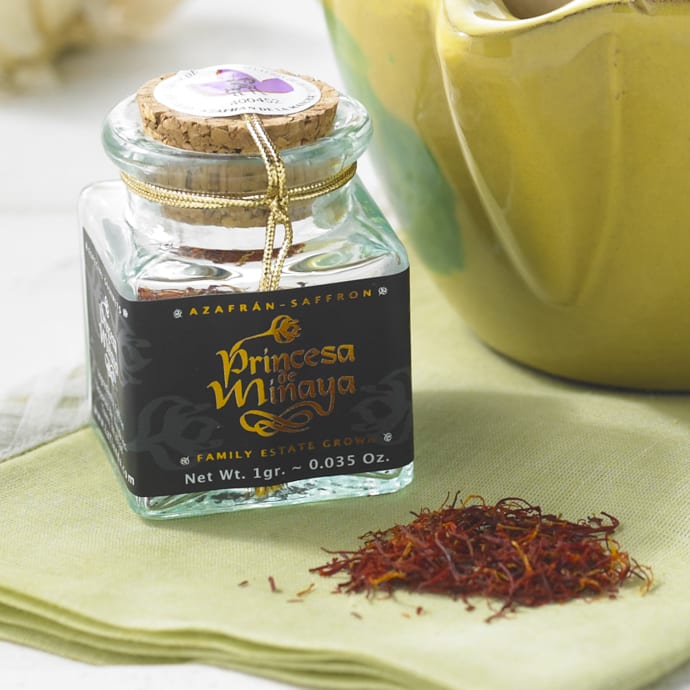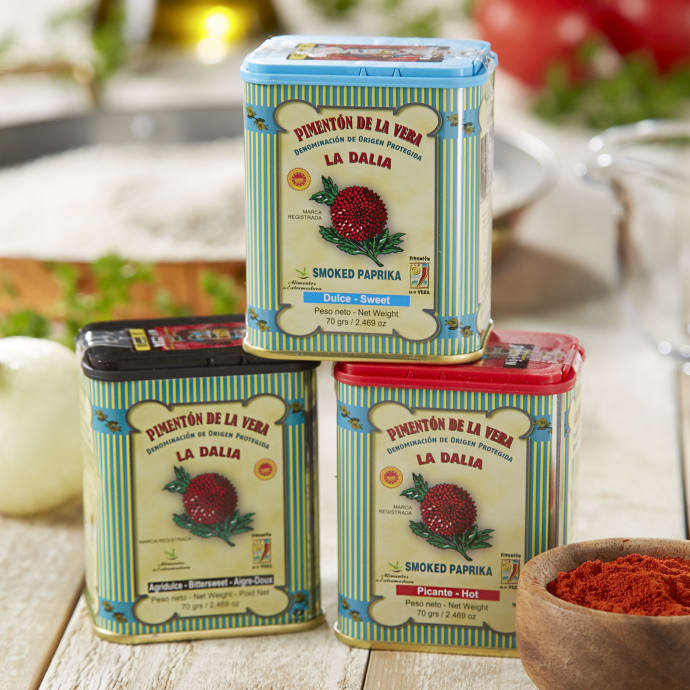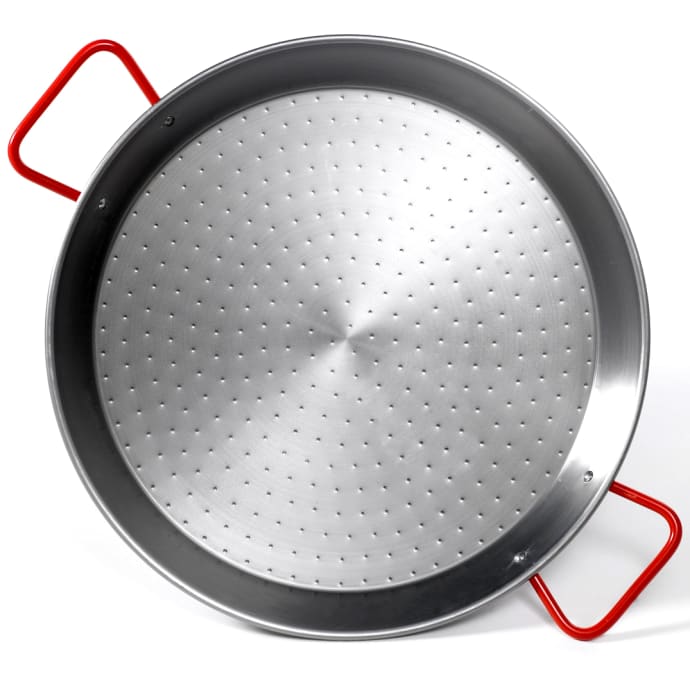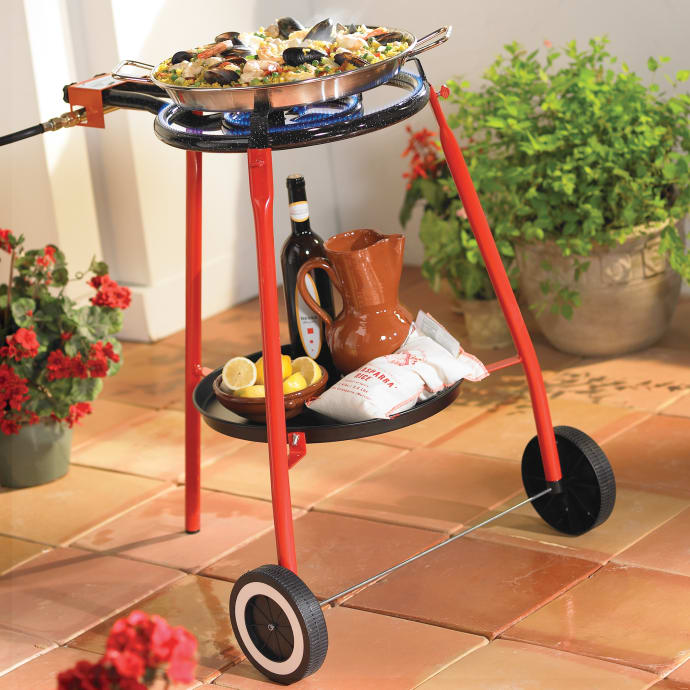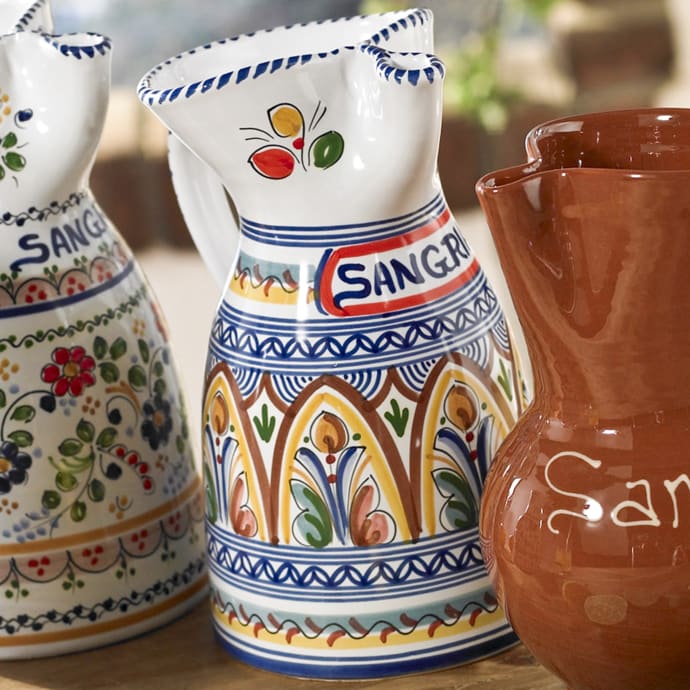
Inspired by Spain
The Oregonian
-
September 16, 2008
Martha Holmberg/Jamie Francis
The days are getting shorter, but the sunlight is a generous honeyed gold, and our markets and gardens are a glorious collision of late summer and early autumn vegetables -- sweet peppers, onions, garlic, green beans, eggplant and, of course, tomatoes of every dimension.
The cooking of Spain is a great place to look for inspiration when it's time to cook all that good stuff. In this issue, we're featuring two iconic Spanish dishes that highlight fresh produce -- gazpacho and paella -- along with a trio of quick Iberian-inspired appetizers to share with friends while you sit on your deck and hang on to these last sweet days of summer.
Recipes included with this story: Really Good Paella
In the real deal, it's all about the rice
Here are the three keys for an authentic dish -- and all the ingredients are available locally
Paella lives in parallel universes: There's the paella that most of us have eaten and enjoyed -- a deep bed of rice perhaps flavored with tomato and saffron, garnished with bits of vegetables, seafood, chicken or sausage. All kind of moist and a tad bit mushy but tasty enough.
And then there's real paella. There are as many interpretations of real paella as there are cooks in Spain, but each of those authentic versions, whether garnished with seafood, duck, sausage or rabbit, is about the rice. Not the quantity of rice, but the qualities ... of tender grains that hang onto just a bit of chewiness, of rice that tastes like rice yet is infused deeply with fundamental flavors of Spain: tomato, onion, olive oil, saffron, smoky paprika. And the mercurial quality that seems to distinguish a good paella from a great one: the soccarat -- a thin, chewy-starchy crust that forms on the bottom of the pan ... but only sometimes, if you're lucky.
But you don't have to go to Spain to step into the universe of authentic paella. In fact the only time I've been to Spain, I was eating bread and cheese from a backpack that had a Eurail pass packed inside. But I learned to cook real paella from a friend who lived in Spain and married a Spaniard, and I now consider myself a paella traditionalist -- though my credentials are based on nothing more than enthusiasm.
A good paella musn't be rushed. To start, the sofrito (onion, garlic and tomatoes) should be sauted to concentrate flavors. Only then is rice (preferably the bomba variety) added.
Fortunately, everything you need to make authentic paella is available here in Portland. Here are the three keys.
The rice
Paella wants rice that absorbs lots of flavorful liquid yet stays separate; paella isn't meant to be creamy like risotto. The ideal is a short-grain rice grown in southeastern Spain, called calasparra, of which the bomba designation is even better. These rices are slow-growing, very dry and will absorb significantly more liquid than a regular short-grain rice. You'll need to go to a specialty store, such as Pastaworks or Zupan's, or order some online - tienda.com is a good source for these imported varieties. But in a pinch, Goya medium-grain rice, which is available at most grocery stores, will do fine. Just be extra-vigilant during cooking because the Goya can't absorb as much liquid and will go from chewy to mushy very quickly.
The pan
An authentic paella pan can be a thing of beauty but only for those who find beauty in plain-Jane, utilitarian objects. No gleaming copper or lustrous enameled cast iron here -- traditional paella pans are made of thin steel with a dimpled surface (said to distribute heat evenly, but who knows?) and two loopy metal handles. As you use your pan, it will discolor and take on a patina that's not glamorous but is a satisfying testament to some delicious meals. You can make paella with a wide skillet, too -- the wider and shallower, the better, so that you can spread your ingredients out into a thin layer and the liquid evaporates quickly. Be sure your pan has a heavy base so it heats evenly. You could use nonstick, if that's all you have, but there will be no hope of developing the prized crust on the bottom.
I have a 15-inch Spanish pan, which the manufacturer says will makes paella for six, but it never does ... mostly because the paella is so good that people want to eat a lot. And leftover paella is really good, so I like to plan generously. I usually make two 14-inch pans (one in a T-fal skillet) and it's plenty for six people plus breakfast.
The concentration
By this I mean two things. First, you need to concentrate the flavors of your paella "add-ins" by cooking them to develop flavor before you unite them with the rice. You start with a sofrito, a base of onion, garlic and tomato that adds tremendous flavor, but only if sauteed until thick and concentrated.
If you're using chicken or other poultry, you need to brown it thoroughly to develop flavor in the chicken and on the bottom of the pan, where it will seep into the rice. And other vegetables, such as bell peppers, green beans or artichoke hearts, need precooking to concentrate and sweeten their flavors as well as soften their textures. (Seafood needs a lighter touch, so I tuck it into the rice midpoint, or I cook it separately and add it later.)
The other concentration that's key is the mental kind. When you make real paella, especially the first few times (or in my case, always), you need to concentrate on what's happening in the pan in order to control the absorption of the broth, the texture of the rice, the development of the crust. It's the balance between those simple elements that takes a pan of rice into a universe of deliciousness all its own.
Martha Holmberg: 503-294-5191; marthaholmberg@news.oregonian.com
The days are getting shorter, but the sunlight is a generous honeyed gold, and our markets and gardens are a glorious collision of late summer and early autumn vegetables -- sweet peppers, onions, garlic, green beans, eggplant and, of course, tomatoes of every dimension.
The cooking of Spain is a great place to look for inspiration when it's time to cook all that good stuff. In this issue, we're featuring two iconic Spanish dishes that highlight fresh produce -- gazpacho and paella -- along with a trio of quick Iberian-inspired appetizers to share with friends while you sit on your deck and hang on to these last sweet days of summer.
Recipes included with this story: Really Good Paella
In the real deal, it's all about the rice
Here are the three keys for an authentic dish -- and all the ingredients are available locally
Paella lives in parallel universes: There's the paella that most of us have eaten and enjoyed -- a deep bed of rice perhaps flavored with tomato and saffron, garnished with bits of vegetables, seafood, chicken or sausage. All kind of moist and a tad bit mushy but tasty enough.
And then there's real paella. There are as many interpretations of real paella as there are cooks in Spain, but each of those authentic versions, whether garnished with seafood, duck, sausage or rabbit, is about the rice. Not the quantity of rice, but the qualities ... of tender grains that hang onto just a bit of chewiness, of rice that tastes like rice yet is infused deeply with fundamental flavors of Spain: tomato, onion, olive oil, saffron, smoky paprika. And the mercurial quality that seems to distinguish a good paella from a great one: the soccarat -- a thin, chewy-starchy crust that forms on the bottom of the pan ... but only sometimes, if you're lucky.
But you don't have to go to Spain to step into the universe of authentic paella. In fact the only time I've been to Spain, I was eating bread and cheese from a backpack that had a Eurail pass packed inside. But I learned to cook real paella from a friend who lived in Spain and married a Spaniard, and I now consider myself a paella traditionalist -- though my credentials are based on nothing more than enthusiasm.
A good paella musn't be rushed. To start, the sofrito (onion, garlic and tomatoes) should be sauted to concentrate flavors. Only then is rice (preferably the bomba variety) added.
Fortunately, everything you need to make authentic paella is available here in Portland. Here are the three keys.
The rice
Paella wants rice that absorbs lots of flavorful liquid yet stays separate; paella isn't meant to be creamy like risotto. The ideal is a short-grain rice grown in southeastern Spain, called calasparra, of which the bomba designation is even better. These rices are slow-growing, very dry and will absorb significantly more liquid than a regular short-grain rice. You'll need to go to a specialty store, such as Pastaworks or Zupan's, or order some online - tienda.com is a good source for these imported varieties. But in a pinch, Goya medium-grain rice, which is available at most grocery stores, will do fine. Just be extra-vigilant during cooking because the Goya can't absorb as much liquid and will go from chewy to mushy very quickly.
The pan
An authentic paella pan can be a thing of beauty but only for those who find beauty in plain-Jane, utilitarian objects. No gleaming copper or lustrous enameled cast iron here -- traditional paella pans are made of thin steel with a dimpled surface (said to distribute heat evenly, but who knows?) and two loopy metal handles. As you use your pan, it will discolor and take on a patina that's not glamorous but is a satisfying testament to some delicious meals. You can make paella with a wide skillet, too -- the wider and shallower, the better, so that you can spread your ingredients out into a thin layer and the liquid evaporates quickly. Be sure your pan has a heavy base so it heats evenly. You could use nonstick, if that's all you have, but there will be no hope of developing the prized crust on the bottom.
I have a 15-inch Spanish pan, which the manufacturer says will makes paella for six, but it never does ... mostly because the paella is so good that people want to eat a lot. And leftover paella is really good, so I like to plan generously. I usually make two 14-inch pans (one in a T-fal skillet) and it's plenty for six people plus breakfast.
The concentration
By this I mean two things. First, you need to concentrate the flavors of your paella "add-ins" by cooking them to develop flavor before you unite them with the rice. You start with a sofrito, a base of onion, garlic and tomato that adds tremendous flavor, but only if sauteed until thick and concentrated.
If you're using chicken or other poultry, you need to brown it thoroughly to develop flavor in the chicken and on the bottom of the pan, where it will seep into the rice. And other vegetables, such as bell peppers, green beans or artichoke hearts, need precooking to concentrate and sweeten their flavors as well as soften their textures. (Seafood needs a lighter touch, so I tuck it into the rice midpoint, or I cook it separately and add it later.)
The other concentration that's key is the mental kind. When you make real paella, especially the first few times (or in my case, always), you need to concentrate on what's happening in the pan in order to control the absorption of the broth, the texture of the rice, the development of the crust. It's the balance between those simple elements that takes a pan of rice into a universe of deliciousness all its own.
Martha Holmberg: 503-294-5191; marthaholmberg@news.oregonian.com
Other Press
This Classic Garlic Keeper Is the One Thing I Made Sure I Brought Back from Spain
The Kitchn
-
July 10, 2024
That's How the Light Gets In
Defense Visual Information Distribution Service
-
April 20, 2024
See How Jamón Gets Made in the Heartland of Spanish Pork
Washington Post
-
April 16, 2024
No Ortolans Were Hurt During the Making of This Film
New York Times
-
December 12, 2023
Featured Products

Princesa de Minaya Saffron, D.O. La Mancha
SN-09
(53)
$19.00$19.00

Smoked Paprika Trio by La Dalia
PK-12
(52)
$18.00$18.00

Bomba Paella Rice by Peregrino
RC-03
(107)
$19.00$19.00

Wood-Fire Roasted Piquillo Peppers from Lodosa
PQ-14
(25)
$15.00$15.00

17 Inch Traditional Steel Paella Pan - Serves 8
PP-02
(17)
$29.00$29.00

Paella Burner with Rolling Stand and FREE 17 inch Pan
PB-06B
(7)
$296.00$296.00

Hand-Painted Ceramic Sangría Pitcher
CM-07
(20)
$49.00$49.00

Seafood Broth for Paella by El Navarrico
SU-35
(17)
$13.00$13.00

